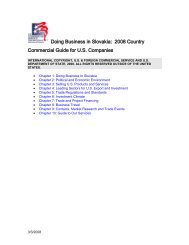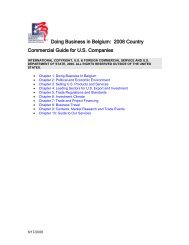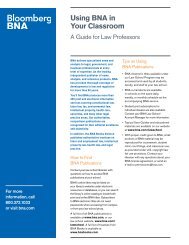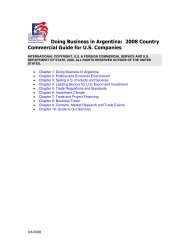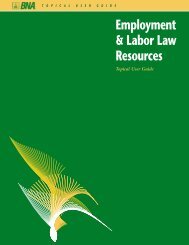Doing Business In (Insert Country Name Here) - BNA
Doing Business In (Insert Country Name Here) - BNA
Doing Business In (Insert Country Name Here) - BNA
You also want an ePaper? Increase the reach of your titles
YUMPU automatically turns print PDFs into web optimized ePapers that Google loves.
Labeling and Marking Return to top<br />
Manufacturers should be mindful that, in addition to the EU’s mandatory and voluntary<br />
schemes, national voluntary labeling schemes might still apply. These schemes may be<br />
highly appreciated by consumers, and thus, become unavoidable for marketing<br />
purposes.<br />
Manufacturers are advised to take note that all labels require metric units although dual<br />
labeling is also acceptable until end of December 2009. The use of language on labels<br />
has been the subject of a Commission Communication, which encourages multilingual<br />
information, while preserving the right of Member States to require the use of language<br />
of the country of consumption.<br />
The EU has mandated that certain products be sold in standardized quantities. Council<br />
Directive 2007/45/EC, to replace 80/232/EC in April 2009, harmonizes packaging of wine<br />
and spirits throughout the EU. Existing national sizes will be abolished with a few<br />
exceptions for domestic producers.<br />
Key Link: [http://ec.europa.eu/enterprise/prepack/packsize/packsiz_en.htm]<br />
The Eco-label<br />
EU legislation in 1992, revised in 2000, distinguishes environmentally friendly products<br />
and services through a voluntary labeling scheme called the Eco-label. Currently, the<br />
scheme applies to 7 product groups: cleaning products, appliances, paper products,<br />
clothing, lubricants, home and garden products and tourism services. The symbol, a<br />
green flower, is a voluntary mark. The Eco-label is awarded to producers who can show<br />
that their product is less harmful to the environment than similar products. This “green<br />
label” also aims to encourage consumers to buy green products. However, the scheme<br />
does not establish ecological standards that all manufacturers are required to meet to<br />
place product on the market. Products without the EU Eco-label can still enter the EU as<br />
long as they meet the existing health, safety, and environmental standards and<br />
Regulations.<br />
The EU Eco-label is a costly scheme (up to EUR 1,300 for registration and up to EUR<br />
25,000/year for the use of the label, with a reduction of 25% for SMEs) and has therefore<br />
not been widely used so far. However, the Eco-label can be a good marketing tool and,<br />
given the growing demand for green products in Europe, it is likely that the Eco-label will<br />
become more and more a reference for green consumers.<br />
Key Links: [http://buyusainfo.net/docs/x_4284752.pdf]<br />
[http://ec.europa.eu/comm/environment/ecolabel/index_en.htm]<br />
[http://www.eco-label.com/]<br />
Biotech Evaluation:<br />
As a result of the French government environmental consultations called “Grenelle de<br />
l’Environnement” in 2007, the evaluation process for biotech products has recently<br />
changed. A new interim biotech authority was created to evaluate biotech products,<br />
including not only scientists but also socio-economical specialists.<br />
[http://www.ecologie.gouv.fr/Composition-du-comite-de.html]<br />
2/15/2008 <strong>Country</strong> Commercial Guide for France 97<br />
INTERNATIONAL COPYRIGHT, U.S. & FOREIGN COMMERCIAL SERVICE AND U.S. DEPARTMENT OF STATE,<br />
© 2007. ALL RIGHTS RESERVED OUTSIDE OF THE UNITED STATES.



